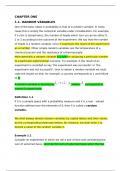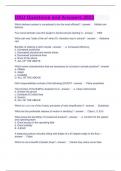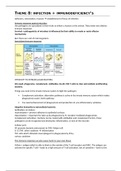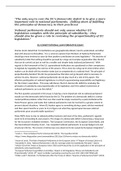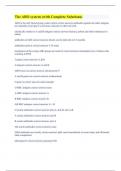LEC 1: Description and Inference
Variable
● ‘Anything that can be measured and can differ across entities or across time’ (Field)
eg hair colour, level of trust in the government, age
Independent & dependent variables
● Intensity of studying - has effect on > performance in exam
● cause (x) -> outcome (y)
Levels of measurement (categorical)
● Variables have different scales / levels of measurement = the nature of information
within values assigned to variables
1) Nominal
a) two or more exclusive categories
b) no natural order
c) no arithmetic operations possible (subtraction, or logical operations like “equal
to” or “greater than”
d) frequency (mode). eg occupation/political party affiliation / favourite football
club
2) Ordinal
a) clear ordering of the values
b) o.a. low←→high; little←→much; small←→large
c) spacing between values not the same across the levels
d) comparison possible but only relative
i) eg level of agreement, level of education, political interest, trust in
government
Levels of measurement
● Continuous variables: interval and ratio
● Both: difference between two values meaningful
3) Interval
- But: the zero is arbitrary / meaningless
- a temperature of 0.0 C to F does not mean ‘no heat’
- eg temperature (F or C). pH (more examples in natural sciences but
distinction nevertheless important)
4) Ratio
- like interval but meaningful zero
- eg height, weight, salary, Kelvin, number of international conflicts
Making things a little more complicated..
● Continuous variables (interval-ratio) are continuous (obviously) but can be discrete
● A “continuous” interval-ratio variable can be measured to any level of precision
○ eg height can take any value; 175.257234237 .. cm
● Discrete interval-ratio variables:
○ Can take only certain, countable values (usually whole numbers)
■ eg points in an exam or number of car accidents at an intersection
● Continuous variables can be measured in discrete terms (eg height cm in whole #
Distribution
, ● When we collect data we can show how data values are distributed in relation to
other values
● Frequency distribution = the distribution of a statistical data set to show all the
possible values (or intervals) of the data and how often (i.e. frequent) they occur
Examples: European Social Survey
Frequency distribution
● Nominal variable (religion or denomination belonging to at time of interview)
● Ordinal variable (level of interest in politics)
● Ratio variable (age)
How can we describe different distributions?
● Measure of central tendency
○ a value that attempts to describe a set of data by identifying the central
position within that set of data
● Measure of dispersion
○ how s t r e c h e d or squeezed is the distribution
Measure of central tendency
Level of measurement Measures of central tendency
Nominal Mode
Ordinal Median + Mode
Interval & Ratio Mean + Median + Mode
1 Mode
● mode is the most frequent score in a data set
● There can be several modes eg in case of same number of Roman Catholic and
Protest respondents in dataset
2 Median
● middle score for a set of data that has been arranged in order of magnitude. Arrange
by magnitude
● What happens when you have an even number of scores?
● Example = 55 + 56 /2 = 55.5
● Middle score for a set of data that has been arranged in order of magnitude
● Example: trust in government
3 2 2 3 1 1 3 3 2 3 2
1 1 2 2 2 2 3 3 3 3 3
● Median = 2
,3 (Arithmetic) Mean
● X = ∑^n = 1 Xi / n
● sigma = sum of
● Average of the numbers
● Example:
65 55 89 57 35 14 56 55 87 45 92
Mean = 65 + 55 + 89 + 57 + 35 + 14 + 56 + 55 + 87 + 45 + → 650/11 ≈ 59.091
● Mean is sensitive to extreme values / outliers
● When there are extreme value in the data set the median may be more useful than
the mean (median not affected by extreme values)
Measure of dispersion
Level of measurement Measures of dispersion
Nominal No measure of dispersion possible
Ordinal Range, Inter-quartile range
Interval & Ratio Range, Inter-quartile range
Variance/standard deviation
How s t r e c h e d or squeezed is the distribution?
Range & Interquartile range
2 8 14 35 45 55 55 56 57 61 65
● Range is the difference between the lowest and highest values: 65 - 2 = 63
● IQR is the range of the middle 50% of the data. Calculate by subtracting the first
quartile from the third quartile: 57 - 14 = 43
○ lower half: first quartile Q1 = median of the n smallest entries
○ upper half: third quartile Q3 = median of the n largest entries
● What if you do not have a median in your two halves?
○ 1st: calculate the mean of the two middle scores for the lower half:
○ 2nd: calculate the mean of the middle scores for the upper half:
○ 3rd: interquartile range =
● What if you have an even set of numbers?
○ Lower half Q1 = median of the n smallest entries
○ Upper half Q3 = median of the n largest entries
○ Split the data in two halves
○ Find the median of the lower half of the data, and the median of the upper half
of the data
○ Calculate IQR = 57 - 35 = 22
, Quartiles: an easy definition
● There are at least 9 alternative methods, see Hyndman and Fan (1996) for quantiles
(cut points)
● SPSS uses a method called HAVERAGE which is the weighted average at X(w+1)*p
Deviance
● Problem: interquartile range uses only only a selection of the data
● Measures of spread using all data. deviance = xi -x
● How much does each value deviate from the mean(x)?
● Example: number of points of students in a test
Possible to... Nominal Ordinal Interval Ratio
compute frequency Yes Yes Yes Yes
distribution/mode?
compute median and No Yes Yes Yes
percentiles?
add or subtract? No No Yes Yes
compute mean, standard No No Ye Yes
deviation, standard error
of the mean?
compute ratio or No No No Yes
coefficient of variation?
Skewness and symmetry
● there is an infinite number of distributions (each with its own mean and its own
standard deviation to characterise it)
● Positive skew: mass concentrated on the left; right tail is longer
● Negative skew: mass concentrated on the right; left tail is longer
Normal distributions
● A common continuous probability distribution in statistics is the ‘Normal Distribution’
● mean = median = mode
● Symmetry: 50% of values less than the mean and 50% greater than the mean
● bell-shaped curve
Different normal distributions
● Both are normally distributed. What are the differences?
Normal distribution
● Two characteristics (‘parameters’) determine shape of distributions:
○ Mean + standard deviation
Variable
● ‘Anything that can be measured and can differ across entities or across time’ (Field)
eg hair colour, level of trust in the government, age
Independent & dependent variables
● Intensity of studying - has effect on > performance in exam
● cause (x) -> outcome (y)
Levels of measurement (categorical)
● Variables have different scales / levels of measurement = the nature of information
within values assigned to variables
1) Nominal
a) two or more exclusive categories
b) no natural order
c) no arithmetic operations possible (subtraction, or logical operations like “equal
to” or “greater than”
d) frequency (mode). eg occupation/political party affiliation / favourite football
club
2) Ordinal
a) clear ordering of the values
b) o.a. low←→high; little←→much; small←→large
c) spacing between values not the same across the levels
d) comparison possible but only relative
i) eg level of agreement, level of education, political interest, trust in
government
Levels of measurement
● Continuous variables: interval and ratio
● Both: difference between two values meaningful
3) Interval
- But: the zero is arbitrary / meaningless
- a temperature of 0.0 C to F does not mean ‘no heat’
- eg temperature (F or C). pH (more examples in natural sciences but
distinction nevertheless important)
4) Ratio
- like interval but meaningful zero
- eg height, weight, salary, Kelvin, number of international conflicts
Making things a little more complicated..
● Continuous variables (interval-ratio) are continuous (obviously) but can be discrete
● A “continuous” interval-ratio variable can be measured to any level of precision
○ eg height can take any value; 175.257234237 .. cm
● Discrete interval-ratio variables:
○ Can take only certain, countable values (usually whole numbers)
■ eg points in an exam or number of car accidents at an intersection
● Continuous variables can be measured in discrete terms (eg height cm in whole #
Distribution
, ● When we collect data we can show how data values are distributed in relation to
other values
● Frequency distribution = the distribution of a statistical data set to show all the
possible values (or intervals) of the data and how often (i.e. frequent) they occur
Examples: European Social Survey
Frequency distribution
● Nominal variable (religion or denomination belonging to at time of interview)
● Ordinal variable (level of interest in politics)
● Ratio variable (age)
How can we describe different distributions?
● Measure of central tendency
○ a value that attempts to describe a set of data by identifying the central
position within that set of data
● Measure of dispersion
○ how s t r e c h e d or squeezed is the distribution
Measure of central tendency
Level of measurement Measures of central tendency
Nominal Mode
Ordinal Median + Mode
Interval & Ratio Mean + Median + Mode
1 Mode
● mode is the most frequent score in a data set
● There can be several modes eg in case of same number of Roman Catholic and
Protest respondents in dataset
2 Median
● middle score for a set of data that has been arranged in order of magnitude. Arrange
by magnitude
● What happens when you have an even number of scores?
● Example = 55 + 56 /2 = 55.5
● Middle score for a set of data that has been arranged in order of magnitude
● Example: trust in government
3 2 2 3 1 1 3 3 2 3 2
1 1 2 2 2 2 3 3 3 3 3
● Median = 2
,3 (Arithmetic) Mean
● X = ∑^n = 1 Xi / n
● sigma = sum of
● Average of the numbers
● Example:
65 55 89 57 35 14 56 55 87 45 92
Mean = 65 + 55 + 89 + 57 + 35 + 14 + 56 + 55 + 87 + 45 + → 650/11 ≈ 59.091
● Mean is sensitive to extreme values / outliers
● When there are extreme value in the data set the median may be more useful than
the mean (median not affected by extreme values)
Measure of dispersion
Level of measurement Measures of dispersion
Nominal No measure of dispersion possible
Ordinal Range, Inter-quartile range
Interval & Ratio Range, Inter-quartile range
Variance/standard deviation
How s t r e c h e d or squeezed is the distribution?
Range & Interquartile range
2 8 14 35 45 55 55 56 57 61 65
● Range is the difference between the lowest and highest values: 65 - 2 = 63
● IQR is the range of the middle 50% of the data. Calculate by subtracting the first
quartile from the third quartile: 57 - 14 = 43
○ lower half: first quartile Q1 = median of the n smallest entries
○ upper half: third quartile Q3 = median of the n largest entries
● What if you do not have a median in your two halves?
○ 1st: calculate the mean of the two middle scores for the lower half:
○ 2nd: calculate the mean of the middle scores for the upper half:
○ 3rd: interquartile range =
● What if you have an even set of numbers?
○ Lower half Q1 = median of the n smallest entries
○ Upper half Q3 = median of the n largest entries
○ Split the data in two halves
○ Find the median of the lower half of the data, and the median of the upper half
of the data
○ Calculate IQR = 57 - 35 = 22
, Quartiles: an easy definition
● There are at least 9 alternative methods, see Hyndman and Fan (1996) for quantiles
(cut points)
● SPSS uses a method called HAVERAGE which is the weighted average at X(w+1)*p
Deviance
● Problem: interquartile range uses only only a selection of the data
● Measures of spread using all data. deviance = xi -x
● How much does each value deviate from the mean(x)?
● Example: number of points of students in a test
Possible to... Nominal Ordinal Interval Ratio
compute frequency Yes Yes Yes Yes
distribution/mode?
compute median and No Yes Yes Yes
percentiles?
add or subtract? No No Yes Yes
compute mean, standard No No Ye Yes
deviation, standard error
of the mean?
compute ratio or No No No Yes
coefficient of variation?
Skewness and symmetry
● there is an infinite number of distributions (each with its own mean and its own
standard deviation to characterise it)
● Positive skew: mass concentrated on the left; right tail is longer
● Negative skew: mass concentrated on the right; left tail is longer
Normal distributions
● A common continuous probability distribution in statistics is the ‘Normal Distribution’
● mean = median = mode
● Symmetry: 50% of values less than the mean and 50% greater than the mean
● bell-shaped curve
Different normal distributions
● Both are normally distributed. What are the differences?
Normal distribution
● Two characteristics (‘parameters’) determine shape of distributions:
○ Mean + standard deviation




